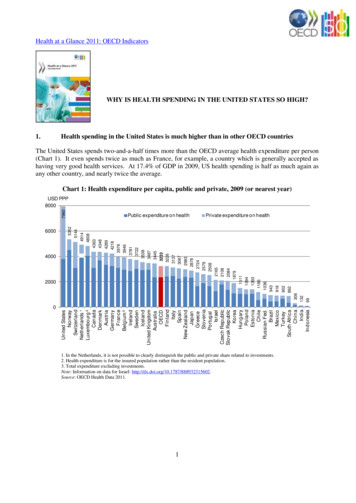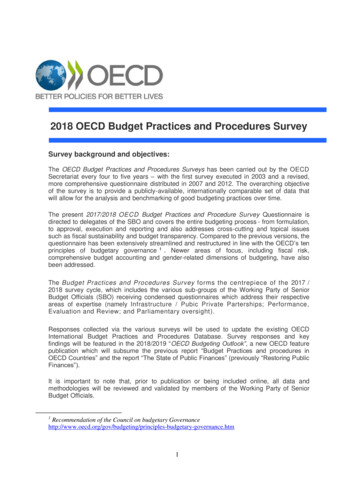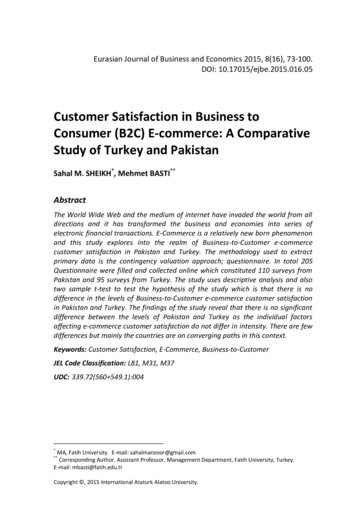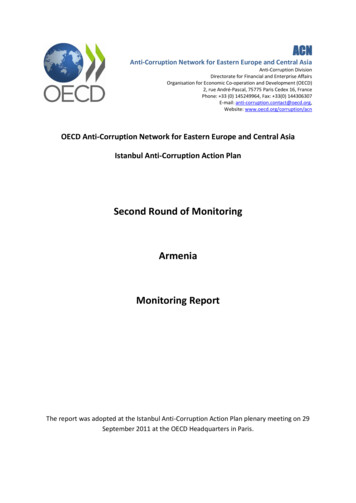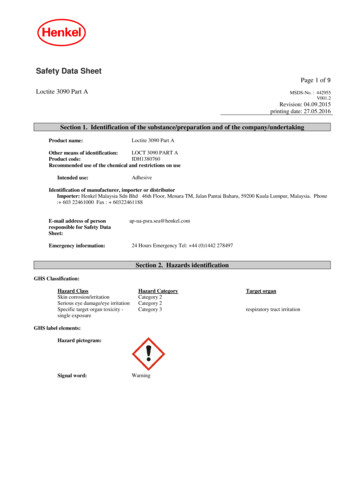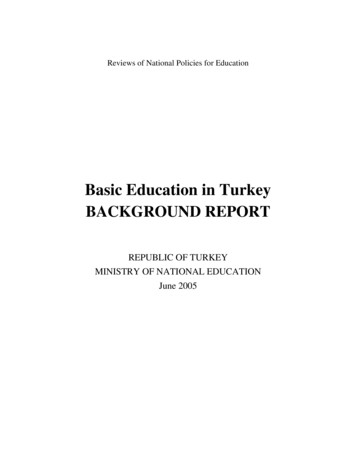
Transcription
OECD, 2002. Software: 1987-1996, Acrobat is a trademark of ADOBE.All rights reserved. OECD grants you the right to use one copy of this Program for your personal use only.Unauthorised reproduction, lending, hiring, transmission or distribution of any data or software isprohibited. You must treat the Program and associated materials and any elements thereof like any othercopyrighted material.All requests should be made to:Head of Publications Service,OECD Publications Service,2, rue André-Pascal,75775 Paris Cedex 16, France. OCDE, 2002. Logiciel, 1987-1996, Acrobat, marque déposée d’ADOBE.Tous droits du producteur et du propriétaire de ce produit sont réservés. L’OCDE autorise la reproductiond’un seul exemplaire de ce programme pour usage personnel et non commercial uniquement. Saufautorisation, la duplication, la location, le prêt, l’utilisation de ce produit pour exécution publique sontinterdits. Ce programme, les données y afférantes et d’autres éléments doivent donc être traités commetoute autre documentation sur laquelle s’exerce la protection par le droit d’auteur.Les demandes sont à adresser au :Chef du Service des Publications,Service des Publications de l’OCDE,2, rue André-Pascal,75775 Paris Cedex 16, France.
ISSN 1608-7143OECD Journal on Budgeting – Vol. 2, No. 3 OECD 2002Regulatory Governance: Improvingthe Institutional Basis for Sectoral RegulatorsbyCésar Córdova-Novion and Deirdre Hanlon** César Córdova-Novion is Deputy Head of Programme, Regulatory ReformDivision, Directorate for Public Governance and Territorial Development, OECD,with the assistance of Ye Tao, Consultant. Deirdre Hanlon wrote this report whileon temporary secondment to the OECD from the Department of Public Enterprise,Ireland.OECD JOURNAL ON BUDGETING – Vol. 2, No. 3 – ISSN 1608-7143 – OECD 200257
REGULATORY GOVERNANCE: IMPROVING THE INSTITUTIONAL BASIS FOR SECTORAL REGULATORS1. IntroductionIn recent years, many countries, both within the OECD and beyond, havereappraised their regulatory policy framework to determine whether it meetsthe challenges of the new regulatory environment. For utility marketspreviously characterised by stability and slowness to change, these challengesare arising from rapidly developing technologies, converging industries, theinternationalisation of markets, and more informed and discerning consumers.The reassessment and subsequent realignment of the regulatoryapproach has sometimes been done on the initiative of the individual countryor in the context of international regulatory developments – as with severalEuropean Union member states. While both the literature and the work ofgovernments show strong analysis of regulatory objectives and of regulatoryinstruments, there is relatively little evidence of strategic critique and policyadvice on the institutional setting for sectoral regulation. Yet, as every policymaker and regulatory practitioner knows, institutional setting has adetermining effect on regulatory service delivery.This report aims to identify and examine some of the key issues in relationto the design of the institutional framework for economic regulation, particularlyin the infrastructure network industries, such as telecommunications,electricity, gas, water and rail.1 Its purpose is to generate discussion of regulatoryinstitutional design and to set a framework for understanding and determiningbest practice for the governance of these institutions.2 As such, the report isconstructed around various matters that typically underlie the deliberations ofthe central government policy-makers who design the institutional frameworkwithin which economic regulatory functions are executed.The principal focus of this report is the institutional design of theadministrative system charged with economic regulatory functions. It is clearthat institutional design issues are not informed only from the publicmanagement or the regulatory reform perspectives; rather they are related tomany other factors across the wider economic, political and administrativespheres within which regulation is carried out.This report considers the economic regulatory context – regulation whoseprimary purpose is to facilitate, imitate or enhance markets by correcting forentry imperfections and dealing with price, quality and reliability of service,supplier market entry and exit, and infrastructure investment. Institutional58OECD JOURNAL ON BUDGETING – Vol. 2, No. 3 – ISSN 1608-7143 – OECD 2002
REGULATORY GOVERNANCE: IMPROVING THE INSTITUTIONAL BASIS FOR SECTORAL REGULATORSdesign for other regulatory contexts (e.g. safety, public health, social orenvironmental regulation) is not considered in detail, except in so far aseconomic regulatory bodies are additionally charged with non-economicfunctions. 3 Therefore, reference in this report to regulation should beunderstood to mean economic regulation, unless otherwise specified.In the economic regulatory context, network industries represent thearena in which there has been the most recent and most rapid development inrelation to regulatory frameworks. The rate of change in recent years in there gu la tory env iron m e nt for n e twor k i nd us tri e s – m os t n otably intelecommunications, but also in energy, water, rail and postal services – acrossmany OECD member countries has generated a base of regulatory experiencethat contributes to a better understanding of economic regulation at thehorizontal level.4The financial services sector also provides valuable economic regulatoryinsights. However, because financial markets are characterised by high levelsof systemic risk, economic regulation of financial services is highly influencedby prudential considerations, often to be observed in the regulatory focus onthe integrity of th e financial system rathe r than on compe tition orconsumers.5 Financial services regulation can also be highly motivated bymacroeconomic policy, and in some instances is used as a tool of monetarypolicy. Although certainly economic, these prudential and monetary policyregulatory drivers are very particular to the financial services sector and donot typify economic regulation in the broader context; in particular, they canobscure the market-facilitating rationale for regulation. Therefore, this reportprimarily refers to network industries, rather than financial services.This section has introduced the report in terms of background, purpose,focus and scope. In Section 2, the discussion progresses to consideration of thecontext of the report: the justification for economic sectoral regulation anddevelopments in relation to the institutional setting for such intervention –specifically the trend in the transfer of regulatory functions from ministries toindependent bodies.Sections 3, 4 and 5 consider three elements in regulatory institutionaldesign: independence, accountability and coherence. There is an examinationof independence in the regulatory context that encompasses both the theoryand many practical considerations in relation to the regulatory bodies’distance from government, industry and other stakeholders. This is followedby an exploration of the balancing effect of regulatory accountability and areflection on the need to legitimise the regulatory process within thedemocratic system. The coherence of the regulatory institutional approachwith existing political, administrative and judicial structures is alsoconsidered.OECD JOURNAL ON BUDGETING – Vol. 2, No. 3 – ISSN 1608-7143 – OECD 200259
REGULATORY GOVERNANCE: IMPROVING THE INSTITUTIONAL BASIS FOR SECTORAL REGULATORSSection 6 considers the efficiency of the regulatory institutional design,w ith a particular e mphasis on the flexibility-rig idity dynamic. Theinstitutional design aspects of measuring the performance of regulatorybodies are also considered.2. Economic regulation and network industries2.1. Regulation – generic and sectoralRegulation is an intervention between the parties to a transaction.Regulation, in the broad sense of the term, can facilitate transactions becauseit is the means used to provide the basic framework under which the partiescan conduct their business in a secure environment. Such a frameworkincludes the regulatory provision or guarantee of human rights, a judicialsystem, property rights, rules of contract and competition. Regulatoryintervention of this kind is generic; it applies across the whole of the economyand society. Some of these regulatory interventions are so fundamental to theoperation of a society and its economy that they are built into its politicalconstitutions. Others are the subject of statute. More still are given effectthrough secondary legislation. They are all forms of regulation.This report is concerned with a narrower definition of regulation. Itsfocus is regulation for a particular economic sector; rules that are specific to acertain group, or industry, or activity and that exceed those rules that apply toother groups in society or other transactions in economic life. This narrowerconcept of regulation constitutes not only intervention between parties to thetransaction, but in fact, an interference with the manner in which eventswould unfold in the absence of the regulatory intervention. Viewed from thisperspective, a regulatory intervention will complicate the transaction and giverise to costs, although it may be justifiable at least over a given time horizon.Such intervention or interference is desirable – or in economic terms,efficient – only where it leads to an improvement in the outcome of thetransaction and where the value of that improvement outweighs the costsinvolved.6 Measuring the improvement can often be difficult as the benefitsmay be manifest across one or more of a wide-range of fields – incomeredistribution, customer safety, public health, investor confidence, systemintegrity – and attributing a value to the identified benefits is a subjectiveexercise. Similarly, there may be problems in assessing the level of costsassociated with the regulatory intervention. Firstly, the costs may be spreadw idely within the economy across the public sector, regulatee s andconsumers. Secondly, certain costs of regulation (e.g. reduced attractiveness ofhighly regulated areas to some foreign direct investment) are intangible anddifficult to correlate correctly with the regulatory cause. Thirdly, costs mayoccur over time.60OECD JOURNAL ON BUDGETING – Vol. 2, No. 3 – ISSN 1608-7143 – OECD 2002
REGULATORY GOVERNANCE: IMPROVING THE INSTITUTIONAL BASIS FOR SECTORAL REGULATORS2.2. Economic regulation and marketsEconomic regulation concerns those interventions whose purpose isrelated to improving the functioning of the market.7 In market economies,and certainly among most OECD member countries, economic regulation is ameans of facilitating the functioning of a particular market with a view toincreasing its economic efficiency. In non-market economies, by contrast,economic regulation is actually the controlling mechanism that substitutesfor a true market situation.The tradition al econ omic rationale for reg ulation conce rns themaximisation of efficiency in monopoly markets.8 The significant economies ofscale and scope attaching to certain activities can mean that competitionbetween several supply-side operators (at least within a given region) wouldinvolve a wasteful use of resources that could be avoided by a single supplier– the natural monopolist. However, economic theory demonstrates thatmonopoly markets are inherently inefficient because, in the monopolist’srational search for super-normal profits, potential consumer welfare isunrealised. The economic basis for regulating markets, therefore, is to helprealise this welfare loss, and thus increase economic efficiency.A further economic rationale for regulation is to deal with the marketfailure in relation to externalities. Some transactions give rise to societalbenefits or costs that are not factored into the market’s pricing mechanism;these benefits and costs are said to be external to the market. They concernthe wider, third party effects of certain transactions that the principal partiesare not economically motivated to consider as part of their pricing analysis.Externalities related to the system integrity and market confidence are animportant consideration in the regulation of financial services.A more recent justification for regulation concerns the correction ofpower or information asymmetries. These occur where one side of the marketis more organised or more powerful and has better access to information thanthe other; typically, the discussion concerns a supply side monopoly oroligopoly, but it can extend to other situations in which one side is, forexample, at a significant informational disadvantage to the other.9 In suchinstance, regulatory intervention can be merited in order to strike anappropriate balance between the interests of producers (cost recovery, profitmaximisation, increased market share) and the interests of consumers (readyaccess, quality services, reasonable prices).Finally, the case is often argued for regulatory intervention in facilitatingmarket transition – although the argument may be based more on publicmanagement tenets than on economics. It applies in markets that previouslywere monopolies (natural or otherwise) and that are moving to competition,whether in whole or in part. In such instances, the incumbent formerOECD JOURNAL ON BUDGETING – Vol. 2, No. 3 – ISSN 1608-7143 – OECD 200261
REGULATORY GOVERNANCE: IMPROVING THE INSTITUTIONAL BASIS FOR SECTORAL REGULATORSmonopolist can use its dominant position to stymie or delay the marketliberalisation process.10 A pro-active regulatory intervention in the markettherefore may increase the effectiveness of the liberalisation programme.Often this intervention takes the form of the regulation of market entry, priceand access to networks, with an emphasis on promoting competition.2.3. Deciding on the necessity of sectoral economic regulationA fundamental element for the successful operation of a regulatorconcerns the clear exposition of whether regulatory intervention – and, byextension, an institution charged with regulatory functions – is required at all.For most goods and services, the dynamics of the market combined with thefacilities of basic economic framework laws, especially the competition law,are sufficient to deal with sectoral issues so that no special economicregulatory approach is needed.In some circumstances, however, policy-makers come to an alternateconclusion.11 They consider that the existing horizontal mechanisms areinsufficient to permit market efficiency, ensure consumer protection orfacilitate dispute resolution within their economic systems are insufficient, atleast in the short-term. They argue that special instruments are required tohelp overcome the deficiencies of the existing legal and administrativesystems in responding to the challenges of the relevant sectors. In otherwords, a sectoral regulatory response is required.Policy-makers in different jurisdictions sometimes come to differentdecisions about similar situations, though. A notable example is New Zealandwhere, until recently, market forces, underpinned by the horizontal legalframework, were regarded as being sufficient for efficient operation of thetelecommunications market; this contrasted with the view of most OECDmember countries that their own telecommunications industries requiredspecial regulation at that stage (See Box 1). Even within a single jurisdiction,the assessment of the desirability for specific regulation can change over time;the fact that a newly-liberalised network market may have required specificregulation five years ago does not imply that such intervention will still berequired in a further five years’ time.2.4. Economic regulation of networksRegulation of the network industries or of utilities have been justifiedfrom one or many of the previous rationale underpinning the need to improveefficiency in imperfect markets. Traditionally, the network sectors have beencharacterised by the following traits: 62necessity for a supply/distribution network that had a large fixed element,that entailed high capital costs and whose life-cycle spans for decades;OECD JOURNAL ON BUDGETING – Vol. 2, No. 3 – ISSN 1608-7143 – OECD 2002
REGULATORY GOVERNANCE: IMPROVING THE INSTITUTIONAL BASIS FOR SECTORAL REGULATORSBox 1. New Zealand’s regulatory approach to network industriesIn New Zealand, the approach to the regulation of network industries isbased on the principle that access to essential facilities should be determinedby negotiations between the parties rather than imposed by a regulator. Underthis “light-handed” approach there are no price controls or other traditionalforms of regulation nor are there industry specific regulators. Instead, theregime for network industries relies primarily upon general competition lawadministered by the competition authority, the Commerce Commission. Thisapproach means that the courts play a greater role in the supervision ofnetwork industries in New Zealand than in most other OECD membercountries that have sector specific regulation. Industry specific informationdisclosure rules, which are designed to make transparent the operations offirms with monopoly power and administered by relevant ministries, are alsoimportant in monitoring enterprises. The main institutional players under theregulatory framework, therefore, are the Commerce Commission, relevantministries and the courts.ElectricityThe Ministry of Economic Development has general responsibility for energypolicy (apart from energy efficiency, which is dealt with by the Ministry for theEnvironm en t) an d for the deve lopmen t of the industry. Its spe cificresponsibilities in the area of electricity include: compilation of statistics andprojections; administering the rules on disclosure of information by electricitycompanies; developing rules and codes of practice relating to the safety,quality and measurement of electricity, and the promotion of health and safetyin the electricity sector; and the registration and ongoing competence ofelectrical workers.The Commerce Commission has been active in all aspects of competition lawaffecting companies in the electricity industry including: approval of mergersand acquisitions between power companies; authorisation of pricingmechanisms and other rules governing the wholesale market; examination ofcomplaints regarding access to the network and other alleged cases of anticompetitive behaviour; and conducting educational programmes to informand advise electricity companies of their obligations under competition law.In 2000, the New Zealand Government announced plans to reform theregulatory framework for the electricity market. These include a reinforcementof the provisions that would allow government to regulate if industryperformance is not satisfactory, a requirement to establish a transmissionpricing methodology by the transmission company that will have to be approvedOECD JOURNAL ON BUDGETING – Vol. 2, No. 3 – ISSN 1608-7143 – OECD 200263
REGULATORY GOVERNANCE: IMPROVING THE INSTITUTIONAL BASIS FOR SECTORAL REGULATORSBox 1. New Zealand’s regulatory approach to network industries(cont.)by the government, and some provisions on electricity prices for smallconsumers.TelecommunicationsIn relation to the telecommunications market, the Ministry of Commerce hasthe role of advising the government on the appropriateness of sectoralregulation, and the Commerce Commission oversees the telecommunicationsmarket based on the general competition law, the Commerce Act. In general,there is no sector specific regulatory requirement. However, there are somespecial obligations on Telecom New Zealand, “Kiwi Share Obligations”, that areset out in the company’s constitution and in effect regulate the price andavailability of residential telephone service; in addition, telecommunicationscompanies in New Zealand have established a Number Administration Deedmechanism to address future numbering issues.While this light-hand approach would remain unchanged, the governmentpowers to regulate the network industries would be reinforced. Earlier in 1991,the government issued a statement on its policy for competition in thetelecommunications market, which threatened to impose sector specificregulation if the current system fails.Source: IEA(2001) and OECD(2000b). a huge infrastructural significance – the electricity, gas, water, rail andcommunications industries being the networks underlying economicdevelopment; derived, rather than an intrinsic demand for many network services; and asymmetry of market power with usually one or few powerful supply-sideoperators and many unorganised parties on the demand side.2.5. Evolution of the institutional approach to network regulationAs a result of the above combination of characteristics governmentsdeveloped specific institutional approaches to regulate network industries –some of which are still dominant in a number of OECD member countries.Following significant nationalisation initiatives during the first part of the pastcentury, network services were often delivered through state ventures.Ownership was deemed a key element of the regulatory framework and publicmonopolies tended to be regulated directly by the shareholding line ministry64OECD JOURNAL ON BUDGETING – Vol. 2, No. 3 – ISSN 1608-7143 – OECD 2002
REGULATORY GOVERNANCE: IMPROVING THE INSTITUTIONAL BASIS FOR SECTORAL REGULATORSthrough its influencing corporate and commercial decisions of the utilityenterprise. The main rationales to put the public services beyond the scope ofthe private sector in many countries were the urgency to expand universalcoverage and assure low prices of the services. Alternatively, in somecountries the state control over delivery of utility services was effectedthrough long-term franchise and concession arrangements with privatemonopolies. With the exception of the United States and Canada, whereseparate and independent utility regulatory commissions or boards involvedin the regulation of private monopolies have existed for many decades, strictministerial supervision of the market complemented the public sectorinvolvement in service delivery.12 Often a single line ministry was maderesponsible for the roles of policy-maker, service provider and marketregulator for a given sector.By the 1980s, the multi-function model of ministerial intervention in thenetwork sectors was coming under criticism in some countries. On one hand,the shortcomings of state-ownership became increasingly visible. Of primaryconcern were management inefficiencies and structural rigidities that limitedthe exploitation of technological advances. Privatisation programmes werelaunched in an attempt to reduce fiscal pressures and refocus management ofthe state’s ministries. On the other hand, the lack of regulatory transparenciesrelated to direct control by the line ministry were exposed. The multiple rolesof ministries in charge of formulating and implementing regulatory policytogether with a variety of other social policies, (including those regardingsectoral development income distribution, and regional growth), fosteredcontradictions and conflicts in policies’ aims. Moreover, the mix of economic,political and social policy considerations made it difficult either to distinguishor to evaluate objectively ministries’ effectiveness and consequently createdaccountability concerns.13The first notable deliberate amendment of the policy-maker/shareholder/regulator model of state involvement in utility markets was made in theUnited Kingdom. A simultaneous divestiture of the state interest in certainutility enterprises coincided with the establishment of dedicated utilityregulatory bodies to oversee the operations of the newly privatised monopolies.14Over the following two decades, many other OECD member countries havereconsidered their approach to state involvement in the network utilities andhave reorganised their involvement in the sectors accordingly (see Table 3). Insome cases, particularly in the earlier years, the selected route was monopolyprivatisation, driven by the fiscal restructuring undertaken by manyeconomies in the 1980s and the early 1990s. Central to the decision were thefiscal considerations related to the cost of state’s continuing to provideinefficient network services and the revenue benefits of realising state assetsand market rights. In later years, the stimulus for change has often beenOECD JOURNAL ON BUDGETING – Vol. 2, No. 3 – ISSN 1608-7143 – OECD 200265
A selection of sectoral regulatory and competition authorities in OECD member countriesTelecommunicationEnergyFinancial sectorCompetition authorityAustralian Prudential RegulationAuthority (APRA) (1998);Australian Securities andInvestments Commission (ASIC)(1998).Australian Competition andConsumer Commission(ACCC)(1995).OECD JOURNAL ON BUDGETING – Vol. 2, No. 3 – ISSN 1608-7143 – OECD 2002AustraliaAustralian Communications Authority Australian Competition and(ACA) (1997);Consumer CommissionAustralian Competition and Consumer (ACCC)(1995).1Commission (ACCC)(1995);1Australian Broadcasting Authority(ABA) (1992).AustriaAustrian Regulatory Authorityfor Telecommunications andBroadcasting (RTR GmbH)(2001){Formerly Telecom Control(TKC)(1997)};The Telekom-Control Commission;The Austrian CommunicationsAuthority (KommAustria).BelgiumBelgian Institute for Postal Serviceand Telecommunications (BIPT).The Electricity and Gas RegulationCommission (CREG).Conseil de la Concurrence(Competition Authority).CanadaCanadian Radio-television andTelecommunications Commission(CRTC) (1968).National Energy Board (1959).*The Federal Competition Bureau.Kartellgericht (Competition Authority).Czech Republic Czech Telecommunication Office(2000);Council for Radio and TelevisionBroadcasting (1992).2Energy Regulatory Office (2001).DenmarkEnergy Supervisory Board (1999).5National Telecom Agency (NTA)(1991).4Czech Securities Commission(1998);3Czech National Bank.Czech Office for EconomicCompetition (1991).The Danish Competition Authority;The Competition Council(Konkurrenceradet) Pre-1990.REGULATORY GOVERNANCE: IMPROVING THE INSTITUTIONAL BASIS FOR SECTORAL REGULATORS66Table 1.
A selection of sectoral regulatory and competition authorities in OECD member countries (cont.)TelecommunicationEnergyFinancial sectorCompetition authorityFinlandFinnish Communications RegulatoryAuthority (2001) {formerlyTelecommunications AdministrationCentre (TAC) 1988}.The Energy Market Authority(2000) {Formerly the ElectricityMarket Authority (SMK) (1995)}.The Finnish Competition Authority(FCA) (1988).FranceL’Autorité de Régulationdes Télécommunications (ART)(1997).Electricity Regulation Commission(2000).Conseil de la Concurrence(The Competition Council)(1 December 1986).GermanyRegulatory Authority forTelecommunications and Posts(Reg TP) (1 August 1996).6Supervisory Board for FinancialServices (Bundesanstalt fürFinanzdienstleistungsaufsicht)(May 2002).GreeceNational Post and Telecommunications Regulatory Authority for EnergyCommission (EETT) (1998).7(1999).Capital Markets Commission (1996). Competition Committee (1991,strengthening an existing body).HungaryCommunication Authority, HIF (1993). Hungarian Energy Office (MagyarEnergia Hivatal, MEH) (1994).IcelandPost and TelecommunicationAdministration (PTA) (1999).IrelandDirector of TelecommunicationsRegulation (ODTR) (1997).8Commission for Energy Regulation Irish Financial Services Regulatory(2002).9Authority (IFSRA) (2002).Irish Competition Authority (1991).ItalyCommunications Authority(for telecoms, television, andpublishing) (1997).Energy Authority (1995).Banca d’Italia (considered anindependent authority only forits competition competencies);ISVAP;CONSOB.Competition Authority (1990).JapanFinancial Supervisory Agency(1998).The Japan Fair Trade Commission(Pre-1990).KoreaFinancial Supervisory Commission(1998, unifying several separatebodies).Korea Fair Trade Commission (1990,building on earlier bodies).Bundeskartellamt (The Federal CartelOffice).Office of Economic Competition,HCO (1990).67REGULATORY GOVERNANCE: IMPROVING THE INSTITUTIONAL BASIS FOR SECTORAL REGULATORSOECD JOURNAL ON BUDGETING – Vol. 2, No. 3 – ISSN 1608-7143 – OECD 2002Table 1.
A selection of sectoral regulatory and competition authorities in OECD member countries (cont.)OECD JOURNAL ON BUDGETING – Vol. 2, No. 3 – ISSN 1608-7143 – OECD 2002TelecommunicationEnergyLuxembourgInstitut Luxembourgeois desTélécommunications (ILT) (1997).Luxembourg TelecommunicationsInstitute (LTI).MexicoFederal Telecommunication Comision Regulatory Energy ComisionFederal de TelecommunicacionesReguladora de Energia (CRE)(COFETEL) (1995).(1995).NetherlandsIndependent Posts andTelecommunications Authority (OPTA)(1997).Financial sectorCompetition authorityBanco de Mexico (the central bank); Federal Competition Comisionthe Banking and Security Industry Federal de Competencia (CFC)Commission (Comision Nacional(1993).Bancaria y de Valores).Netherlands Competition Authority,NMA (1998).New ZealandCommerce Commission (1986).NorwayNorwegian Post andTelecommunications Authority (NPT)(1997).10Water Resources and EnergyDirectorate (NVE) (1986).PolandOffice of Telecommunications and Post Energy Regulatory AuthorityRegulation (URTiP) (replaced URT(1997).(Office of TelecommunicationsRegulation, Oct 2000) on 1 April 2002.The Banking, Insurance andSecurities Commission of Norway(Kredittilsynet) (1986).The Norwegian CompetitionAuthority (NCA) (1994).The Bank Supervision Commission Office for Competition and Consumer(1997);Protection (OCCP).the Polish Communication InsuranceOffice;the Insurance Guarantee Fund;the National Insurance SupervisionFund;the Bank Guarantee Fund(1990, 2000);the Pension Funds SupervisionOffice (1997);the Health Insurance Supervisionoffice (1997);the Spokesman of the
institutional design aspects of measuring the performance of regulatory bodies are also considered. 2. Economic regulation and network industries 2.1. Regulation - generic and sectoral Regulation is an intervention between the parties to a transaction. Regulation, in the broad sense of the term, can facilitate transactions because



